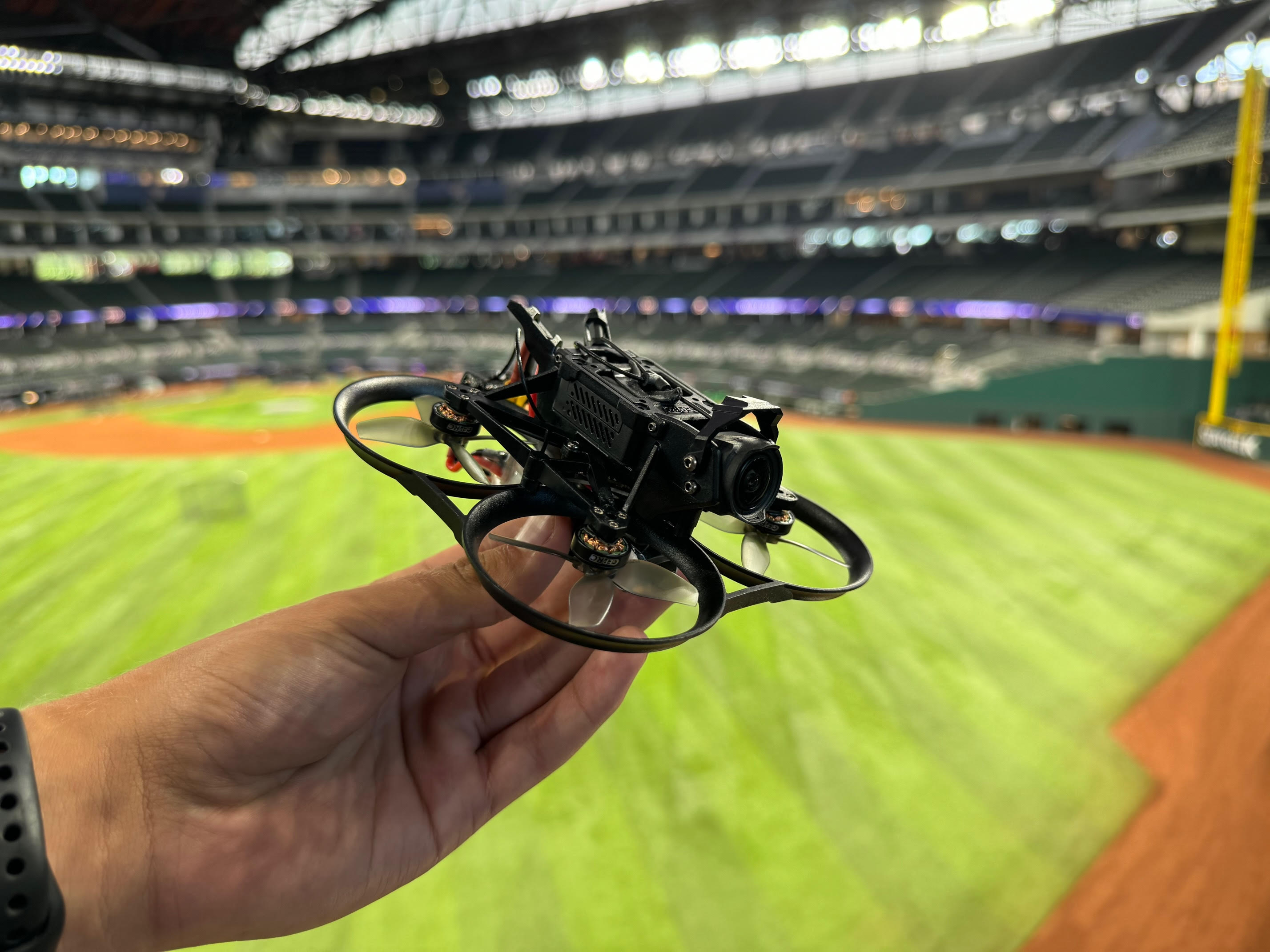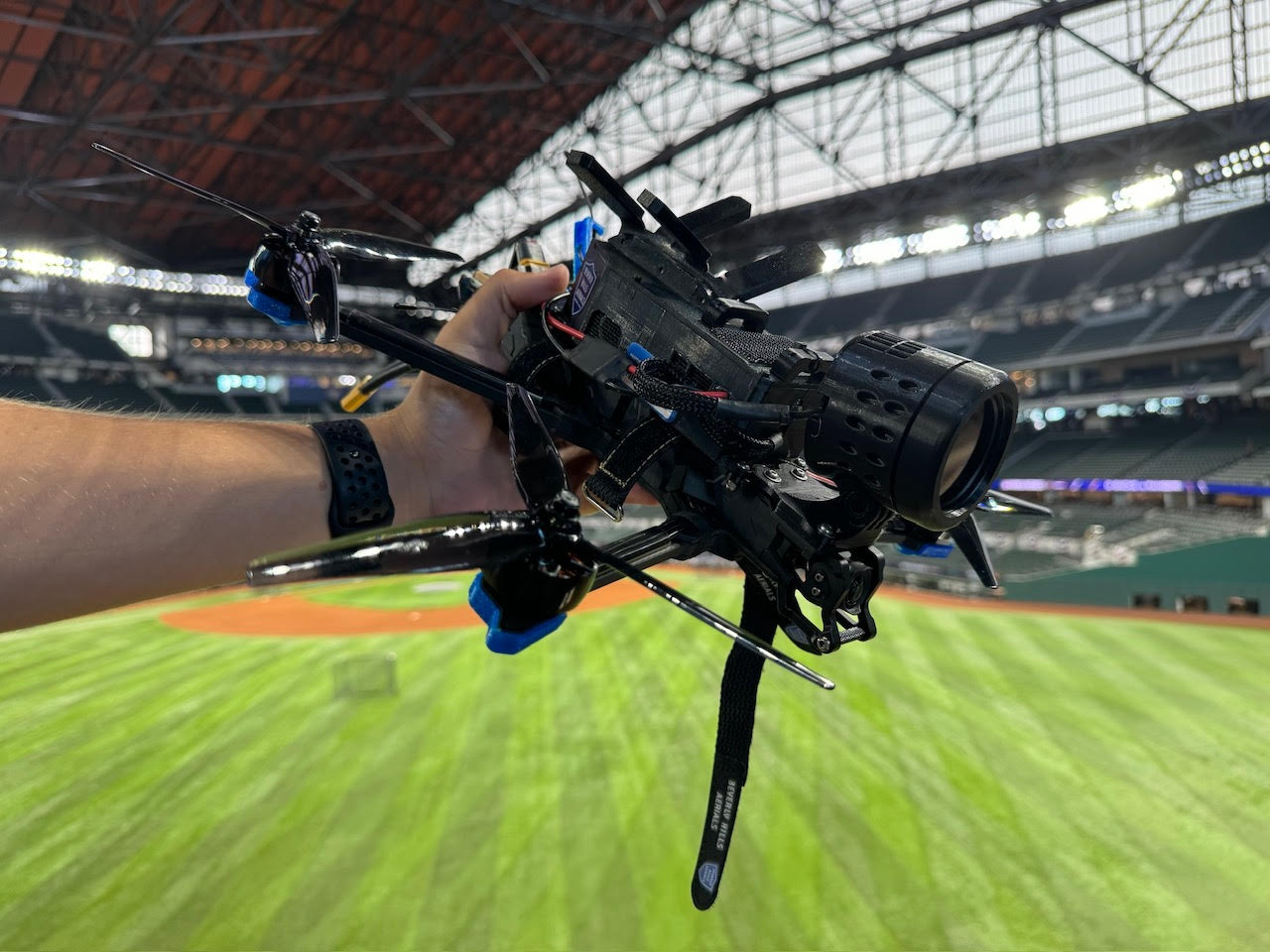
ARLINGTON, Texas—Game 1 of the World Series tonight not only represents a milestone in the evolution of how Fox Sports uses drones as a production element for game coverage, but it may also prove to be the catalyst that pushes them into the mainstream of MLB game production.
This year’s coverage, which begins at 6 p.m. CDT on Fox, Fox Deportes and Fox streaming services, with the game scheduled to start at 7:03 p.m. CDT on October 27, marks the first time the sports broadcaster will use video from drones flying over the field during an MLB game that is not an exhibition contest.
The sports broadcaster is deploying three drones custom-built and operated by Beverly Hills Aerials (BHA), including the Gimbal Bee, Hummer Lite and Hummingbird. Drone use will be confined to dead ball action, such as flying over the outfield to capture shots of a relief pitcher running to the mound from the bullpen or behind the pitcher as he walks off the mound after the last out of an inning, says Brad Cheney, Fox Sports vice president for field operations and engineering.
A Moving Perspective
The drone milestone follows the broadcaster’s use of a drone on the field for production of the 2023 MLB All-Star Game at T-Mobile Park in Seattle. However, MLB regards the All-Star Game as an "exhibition"—an important distinction when it comes to what the league allows.
“You get to do a lot more things in an exhibition,” says Cheney. “All the players wear microphones and all the IFBs and other things. You’re just allowed more leeway. “
Expanded use of drones to include shots from over the field is consistent with other production innovations like two-point wireline cameras going up and down the baselines that capture the fluidity of games, he says.
“It’s another perspective, a moving perspective,” he explains. “That’s the really great thing about baseball. It’s a moving experience. Everything that happens is a reaction to something else, and everyone is moving in concert,” says Cheney.
The professional video industry's #1 source for news, trends and product and tech information. Sign up below.
“By executing the All-Star Game drone use correctly, everybody feels good about it, allowing us to come to the postseason and roll this out."
Brad Cheney
Successful drone use during this year’s World Series between the Arizona Diamondbacks and the Texas Rangers, Cheney is hoping, will be the last step in the process to garnering the go-ahead for regular season use.
“By executing the All-Star Game drone use correctly, everybody feels good about it, allowing us to come to the postseason and roll this out,” he says.
“What we’ve seen with a lot of technology at Fox in partnership with Major League Baseball is that you do some testing—whether during spring training, the All-Star Game or other exhibition—and then slowly get it into postseason. You get a good run at it, and everybody agrees it went well at the most important games of the year.
“Then, we’ll start bringing that new technology into regular season game coverage as will our other partners at Turner, ESPN and MLB Network.”
That’s not to say, however, that broadcasters will deploy drones for every regular season game—at least initially. However, as with other technologies, such as the two-point wireline cameras, drones will become a regular part of coverage over time, he says.
Drone Use
Fox Sports began integrating drone footage into its live productions in 2015 when it used a DJI Octocopter during the Indianapolis Supercross pre-event. Since then, drones have played a role in its coverage of a variety of NASCAR races, including the Daytona 500 and Talladega, and MLB’s Field of Dreams games.
The three drones to be used during coverage of the series won’t be airborne at the same time. Rather, different drones will be used in different circumstances, says Cheney.

Each will be operated under the control of a team from Beverly Hills Aerials. The small drones will be piloted by operators wearing First Person View (FPV) goggles. Spotters working with the pilots will watch the flight space, providing critical flight information to the pilots to ensure safety.
The three drones to be used in Arlington and at Chase Field in downtown Phoenix are equipped with a 4K camera, although the games are being produced in 1080p, says Cheney.
In general, the drones will fly about 25 feet off the field; however, at times they may descend to capture certain shots. As of this writing, it remained undecided whether video transport from the drones would rely on 5G, conventional RF or a combination of the two. However, 5G will be used to link the pilots with the drones for control, says Cheney.
Video signals from the drones will be transported back to the goggle system, which in turn will output it for transport over the broadcaster’s fiber network to its OB vehicles for integration into game coverage, he adds.
Drones and More
As with its coverage of other high-profile events, Fox Sports will rely on a cornucopia of other technology to put its production mark on the games.
That technology includes UmpCam, which made its postseason debut during the American League Division Series, 52 cameras, FlyCam, three DirtCams, 13 Super Motion cameras, three RF cameras and more than 100 microphones.
Still, the 2023 World Series from a video production point of view will likely be remembered for on-field drone use—not just for the series itself but as the mover behind getting drones into coverage of regular season play.
“We're super excited to go ahead with this and figure out what's going to be the next steps and how this becomes a regular part of our production process,” says Cheney. “That's always been our goal here—to apply technology when it actually benefits the fan. And we know this benefits the fan.”
“We really believe this is going to be something that five years from now is not going to be a conversation because everyone's going to have it. It's just going to be another tool and everybody's tool belt.”
More information about the drones is available online.
Phil Kurz is a contributing editor to TV Tech. He has written about TV and video technology for more than 30 years and served as editor of three leading industry magazines. He earned a Bachelor of Journalism and a Master’s Degree in Journalism from the University of Missouri-Columbia School of Journalism.

